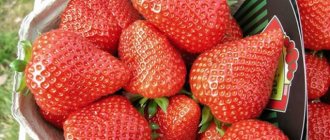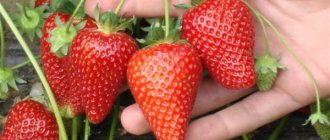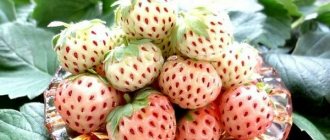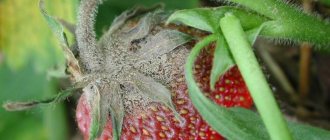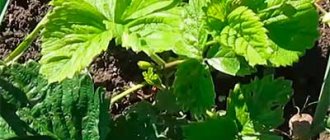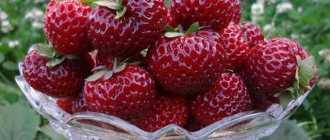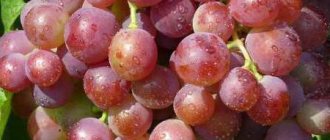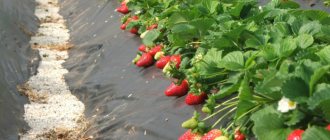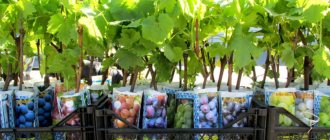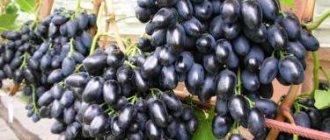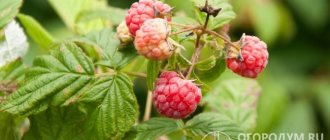Kent is a non-repairing variety of garden strawberry. The Kent strawberry was obtained in 1973 in the city of Kentville (Canada). This variety was developed by scientists from the Canadian Research Station. To obtain this strawberry, the following varieties were used:
- Tioga.
- Raritan.
- Redgauntlet.
In 1978, the variety began testing. In 1981, the Kent variety was officially registered and began to actively spread throughout the world.
In today's publication you will find a description of the Canadian variety of strawberries, see photos of its berries, and also read reviews from gardeners who were lucky enough to grow these garden strawberries on their plots.
Strawberry variety (Victoria) Kent: description, reviews, photos of berries, cultivation, planting and care
By growing vegetables and fruits in their garden plots, summer residents strive to obtain a large amount of products without nitrates and rich in vitamins and minerals. Early ripening varieties are especially valued, since in this case it becomes possible to saturate the body with vitamins in late spring - early summer, when it suffers from vitamin deficiency.
One of the earliest berries to ripen in the garden is strawberries, which can be found in almost any garden plot. The lifespan of a strawberry plantation is not too long - on average 5-6 seasons, and then the plants need to be replaced.
Some gardeners prefer to plant only well-known and proven varieties of strawberries, while others like to experiment, so each time they purchase seedlings of new varieties.
This article will focus on Kent strawberries.
- a variety perfectly adapted for cultivation in regions with a short summer period and harsh winters, description and characteristics, characteristics of cultivation and further care of the berries.
The content of the article:
1. Breeding history 2. Description and characteristics 3. Productivity of the Kent strawberry variety 4. Diseases and pests 5. Advantages of the variety 6. Planting Kent strawberries 7. Further care 8. How to properly feed the bushes 9. Preparing Kent strawberries for winter 10. Reviews about strawberries Kent
Ways to use the crop
Kent strawberries are completely versatile in terms of berry use. They are good both fresh and in all processing. The berries are suitable for jams, compotes, and jams. They are well preserved frozen without losing their beneficial properties in the freezer.
Freezing is the most effective way to preserve strawberries
History of variety development
This strawberry variety is the fruit of selection by Canadian breeders from the city of Kentville, located in the state of Nova Scotia. At a local research station, specialists carried out work on crossing strawberry varieties Raritan and a combination of Tioga and Redgauntlet.
The result of this work was a new strawberry variety, which was given the name K74-10.
This variety was bred at the beginning of the last quarter of the last century, then specialists submitted an application to include it in the State Register. Over the next 3 seasons, these strawberries were tested in special plots located at a local research station. After the tests, experts allowed it to be grown on farms as a test.
Strawberry Kent - photo
As a result, after all the checks carried out, the variety was included in the State Register of the country and received a new name - Kent. It was recommended for cultivation in the regions of Eastern Canada.
In Russia, this strawberry has been grown since the early 90s of the last century.
The Kent variety is currently popular among gardeners in various Russian regions, although many summer residents believe that there are more productive varieties of strawberries.
However, due to its frost resistance and comparative unpretentiousness, Kent strawberries can be successfully grown in the Urals and Siberian regions, where not all varieties of this berry crop take root.
Strawberry Kent: description and characteristics of the variety
The strawberry bushes of this variety are very powerful and erect, but the large foliage is spreading. The leaves grow on elongated petioles, the leaf blades are slightly curved, wrinkled, shiny, bright emerald in color.
Photo of strawberry Evis Delight
The root system grows not only to the sides, but also deep into the soil, so it does not suffer from frost and drought, extracting moisture from deep in the soil. Due to the large size of the roots and above-ground parts, Kent strawberry seedlings should be planted at a distance of at least 0.5 m from each other.
The formation of tendrils on Kent strawberry bushes is average, but by the end of August a sufficient number of them, together with rosettes, are formed to propagate the variety. And yet there are not so many rosettes that the strawberry beds become thicker.
This strawberry is classified as a short-day plant. The strawberry variety Kent is not remontant, so the plantation is harvested only once a summer.
Flower buds begin to form in mid-August; during this period, the length of daylight begins to gradually decrease and becomes less than 12 hours.
Interesting!
The vast majority of strawberry varieties belong to the group of short-day varieties.
Flowering of this variety begins in mid-May, and the first fruits of Kent strawberries ripen early - in early June
, but fruiting is very extended, so this variety is usually not grown on an industrial scale. But for summer residents this is rather a plus, since it becomes possible to stretch out the pleasure of eating ripe strawberries from the garden beds over a couple of weeks.
In the first season after planting, the bushes form no more than 7-8 peduncles, and in the next season - more than 14.
Strawberry Kent - video
In the first year after planting, the fruits of the Kent variety are quite large, weighing at least 35-45 g.
However, with each subsequent year their size begins to decrease.
The berries are round, elongated and conical at the bottom. Sometimes the fruits are heart-shaped.
On a note!
The taste qualities of the Kent strawberry fruits - good, sweetish with a slight sourness of the berries - were rated by tasters from 4.7 to 4.9 points.
The color of ripe strawberries is dark red and shiny, lighter at the stem. The pulp is dense, without voids, juicy, rich red in color. The cuttings are not hard, so it is easy to tear the fruits from the peduncles.
Ripe Kent strawberries have good commercial qualities. It can easily be transported over any distance and can be stored in appropriate conditions for quite a long time.
The purpose of the harvested crop is universal. The fruits are eaten fresh, added to desserts, aromatic preserves, jam, and compotes are prepared. You can put Kent strawberries in the freezer, freezing them for the winter, while the fruits do not lose their taste and presentation.
The strawberry variety Kent is frost-resistant and easily tolerates winters with temperatures dropping to -20 degrees Celsius, and in the Siberian regions it does not freeze out provided there is good shelter.
Opening buds can withstand minor spring frosts, which is very important when growing in Siberia and the Urals, where in the spring there are frequent drops in temperature at the time when flowers bloom on Kent strawberries.
Good varieties of berries:
Cardinal Strawberry Bohemia Strawberry Bonus Blueberry
Another distinctive feature of the Kent strawberry variety is that the bushes definitely need a significant amount of frost time during the winter.
Important!
The Kent variety easily tolerates rainy periods, as well as high humidity, and the taste of the berries does not suffer from this - they gain the required amount of sugars even in such weather.
Harvest and storage
Clery strawberries are distinguished by the rapid ripening of fruits, so the entire harvest can be harvested within two weeks. Ripe berries are removed in portions as they ripen and immediately placed in the containers in which the strawberries will be transported.
The basic rules for collecting and storing berries are listed below:
- the crop is harvested early in the morning after the dew has dried;
- It is recommended to pick fruits only in dry weather - rain causes the berries to quickly become soggy and poorly stored;
- berries need to be picked, stored and transported together with the green stalk - this way they retain their freshness and original shape longer;
- The fruits are stored in the refrigerator - here they remain fresh for up to 6 days.
Important! When in contact with water, strawberries become limp and quickly deteriorate, so it is recommended to wash the berries only immediately before consumption.
Even a novice gardener can grow Clery strawberries - the plants do not require special care, and the agricultural techniques listed in this article will not take much time. In return, you can get a generous harvest of tasty and healthy berries that can be used for a variety of purposes.
I have two beds of CLERY, one in the sun, the other in partial shade. In the sun it ripened 1.06 in partial shade it will just start, the taste is good as always, the berry is large, a market variety.
ilativ https://forum.vinograd.info/showpost.php?p=289596&postcount=6
Diseases and pests
The Kent strawberry variety is noted to be highly resistant to the following diseases:
- various types of leaf spot;
- powdery mildew;
- gray rot;
- strawberry mite attacks.
But resistance to verticillium wilt is below average, but at the level of other strawberry varieties.
Berries
Garden strawberries of the Kent variety produce large, fleshy berries that weigh up to 30 grams. The shape of the fruits is round or heart-shaped, juicy red. A distinctive feature is a tubercle near the neck. Inside the flesh is light red, juicy, dense. They have a pronounced sweet taste. Kent strawberries have a dense structure, so they tolerate transportation and long-term storage well. Entrepreneurs love this view for this reason. It sells itself thanks to its attractive appearance, sweet taste and strawberry smell. These first spring berries are a joy to buy. The fruits can be frozen; they retain their shape well after defrosting. They make excellent jam and preserves.
Due to the weight of the fruits, the flower stalks cannot hold them high. Therefore, the berries often lie on the ground and may begin to rot. Gardeners recommend making devices to support bushes. The strawberry variety Kent produces large fruits only during the first year.
Advantages of the variety
The main advantages of the Kent strawberry variety include:
- large fruit size;
- good taste of Kent strawberries and excellent presentation;
- harvested strawberries tolerate transportation well at different distances without losing their appearance and good taste;
- can be stored for quite a long time under appropriate conditions;
- the bushes produce a sufficient number of tendrils for further propagation, but the plantings do not thicken;
- Kent strawberries are highly resistant to a number of diseases;
- the taste of the fruit does not deteriorate even during the rainy season;
- versatility of the harvested crop;
- Strawberries tolerate frosts down to -20 degrees Celsius well, and with sufficient shelter they winter well in the Urals and Siberia.
But this variety also has its drawbacks:
- strawberries have low resistance to verticillium wilt;
- the berries decrease in size starting from the second season, and by the 4th year after planting the plantation has to be completely changed due to degeneration of the berry plant;
- not too high yield.
Reviews from gardeners
Many gardeners who grew this variety of strawberries were satisfied with it and did not want anything better. Others were in constant search of the best from the good.
Konstantin, 47 years old, Ryazan
I have been growing Kent strawberries for three years now. This is an old proven early variety of strawberry. The first berries can be obtained already in early June. Since they ripen over a long period of time, I harvest the last ones almost at the end of June. Strawberries are very tasty and aromatic. The inside is dense, so it stores and transports well. Forms enough tendrils to propagate for next year. It works best in an annual crop, since the berries already decrease in size the next year. Yes, it has a kind of mark on its first berries, some people don’t like it, but I think that this is the trademark of this variety. This does not affect the taste in any way.
Victoria, 36 years old, Yoshkar-Ola
We grow strawberries for sale. Among others, we tried the Canadian variety Kent. The berry has an attractive appearance, tastes good, is medium in size and ripens quite early. A definite advantage is its ease of care, but the yield is quite average. As a result, it was decided to abandon Kent in favor of more productive varieties.
Stanislav, 50 years old, Arzamas
I accidentally came across this variety at a sale and decided to try it on my site. I have been growing strawberries for quite a long time and I heard about it, and according to its characteristics it seems to be a good variety. And, indeed, it amazed me already in the first year of planting. Our summer was rainy and quite cold. Many other varieties of strawberries were infected with gray rot and all sorts of spots, and I almost never saw any berries from them. But Kent’s berries are large, beautiful and taste sweet and aromatic. There was practically no pain - I didn’t even expect such a result. True, the next year the berries were smaller, but the taste and aroma, as always, did not disappoint. A good variety and, most importantly, one of the most unpretentious.
Planting strawberries of the Kent variety
Kent strawberries can be planted not only in open ground, but also in film greenhouses
, where crop ripening occurs about a week earlier than in the beds.
The place for this strawberry plantation should be sunny and protected from strong drafts and gusts of cold wind. The requirements for the soil are simple - it must be loose, well-permeable to moisture and oxygen, and also sufficiently fertile. Loamy or sandy loam soils are best suited. Sandy soil is not suitable for growing these strawberries, as the moisture from it evaporates quickly. But if necessary, this type of soil can be improved by adding humus or well-rotted compost. The fertilizer application rate is at least 6 kg for each square of area. Such organic matter is usually added during autumn digging of the soil.
Advice!
In heavily acidified soils, lime or dolomite flour is added when digging in the fall, and peat and sand should be added to highly alkaline soils at the rate of 5 kg per 1 m2 of land.
Although this strawberry can easily tolerate strong soil moisture for a short time, it is better not to plant it in lowlands or in places where groundwater comes too close to the surface of the earth.
Usually, Kent strawberry seedlings are transplanted and planted in late August - early September
, using rosette mustaches from his strawberry plantation.
Tips for planting strawberries from a professional - video
If you have to buy Kent strawberry seedlings for planting, it is better to do this in a specialized nursery. When purchasing, you should pay attention to the root system and foliage of the planting material - they should be strong, healthy in appearance, without noticeable damage or signs of disease.
Planting holes should be made at a distance of 0.5 m from each other, since seedlings grow greatly during growth. The distance between rows should also be at least 0.5 m.
To protect plantings from verticillium, it is recommended to place a tablet of the biological product Glyocladin in each hole when planting.
After planting, you should water the bushes well - at least 1.5 liters of water are poured under each plant.
Rules for caring for strawberries Luna
The very next day after planting strawberry seedlings on the site, a long process of plant care begins, the success of which determines the further development and fruiting of the crop.
The main activities in the next few years of cultivation will be regular watering, soil fertilization and the prevention of various diseases and pests. In addition, when growing plants in regions with cold climates, winter shelter may be required.
Prevention and protection against pests and diseases
Strawberries of the Luna variety are characterized by high resistance to the main diseases of strawberries, however, if the soil is waterlogged, gray and white rot may develop
To prevent this from happening, it is important to ration watering and treat the plantings themselves twice a season with 2% Bordeaux mixture: the first time in early spring, and the second time in the fall, shortly after harvesting.
The most popular pests are slugs, which damage not only the leaves of the crop, but also the already formed berries on the bushes. To prevent and eliminate an existing problem, stinging nettles are laid out between the rows or mustard is scattered, which makes it difficult for slugs to move.
1 - Gray rot; 2 - White rot; 3 - Slug.
Watering frequency
During the first two weeks after planting strawberries in a permanent place of growth, you need to water the beds daily, soaking the soil well, but at the same time trying not to wash out the roots.
In the future, the regularity of moistening the substrate is reduced to 1 time every 2 days, and as soon as the young plants are fully strengthened, they can be watered only when necessary, when the top soil layer is completely dry.
To retain moisture for a long time, it is recommended to mulch the rows with straw or sawdust, replacing the layer of mulch approximately once every 2-3 weeks.
Read more about how often and correctly to water strawberries.
Feeding scheme
Since the Luna strawberry variety is a late-ripening variety, when organizing fertilizing, you can adhere to the general fertilizer application scheme for such plants:
- For the first time, strawberries are fed 14 days after they are planted in a permanent place of growth, using ½ cup of wood ash and 30 g of superphosphate as a nutritional composition, which, after mixing with a bucket of water, are poured under each bush (one dose will be enough for 3-4 plants ).
- During the flowering of the bushes, an organic mixture prepared from a week-long infusion of mullein (diluted in water in a ratio of 1:6) and ½ cup of wood ash will be relevant.
- After another 2 weeks, the Luna strawberries can be fed with an organic infusion with the addition of superphosphate fertilizer, repeating this procedure after a few more weeks.
No matter what period you fertilize the crop, you need to add nutrients only after high-quality, abundant watering of the plantings, which will help prevent burns of the root system. In addition, you should not pour fertilizer closer than 5 cm from the trunk of the bush and do more than four main feedings per season.
Preparing for winter
The Luna strawberry variety is characterized by increased resistance to frost, so when grown in the central or, especially, the southern part of the Russian Federation, no special pre-winter preparation of plantings will be required.
As with the cultivation of other varietal varieties of this crop, autumn fertilizing (for example, a 10% solution of mullein mixed with ½ cup of wood ash), abundant watering at the end of September and sanitary pruning of damaged leaves will be sufficient.
You can loosen the soil, but only between the rows, away from the stem part of the plant, which will avoid damage to the root system and death of the strawberry bush.
When growing crops in regions with a very harsh climate and little snowy winters, spruce branches can play the role of snow cover. This material is completely natural and unattractive to rodents, and this is an important detail for the successful wintering of strawberries.
Find out more about how to protect strawberries from frost.
Strawberry Kent: how to properly feed the bushes
Kent strawberries should be fed regularly throughout the season. In the spring, you need to add ammonium nitrate or urea between the rows so that the root system and vegetative mass of the bushes begin to grow more actively.
During budding and ovary formation, a mineral fertilizer containing superphosphate and potassium salt is applied to each bush. After harvesting, fertilizers containing potassium and phosphorus are also applied to the strawberries.
Preparing Kent strawberries for winter
When preparing a strawberry plantation of the Kent variety for winter, it is necessary to carry out the following agrotechnical measures:
- moisture-charging irrigation;
- fertilizer containing organic matter (humus or rotted manure). The layer of such fertilizer should be at least 10-15 cm;
- remove all dried leaves;
- in regions with harsh winters, strawberries are covered with spruce branches, and if necessary, agrofibre is stretched on top. Kent strawberries should be covered with non-woven materials for the winter when the air temperature drops below -5 degrees Celsius and lasts for at least a week.
How to care
Let's get acquainted with the main nuances of caring for Kent strawberries.
Watering
Plants need regular, but not excessive, watering. The procedure is especially important in dry summers. After moisturizing procedures, it is recommended to loosen the soil while simultaneously removing weeds.
Do not over-water the bushes, as this can lead to the spread of a fungal infection, as well as the loss of frost-resistant qualities by the strawberries.
It is advisable to water the bushes at the roots, but in spring, sprinkling irrigation is also recommended, as they improve the growth of green mass. But how to water Marshall strawberries, and what features of feeding this berry can be, is indicated here.
It is important that the water for irrigation is well heated: the optimal temperature is +15-20 degrees. You cannot water Kent with cold water, as this can lead to loss of yield and even to plant disease.
Shelter
This variety can be grown under a thin film cover, which is what many gardeners in our country do. Shelter allows you to harvest the harvest much earlier than with open cultivation, and even makes it possible to collect berries twice during the season.
Trimming
Strawberry Kent forms a mustache, like all other types of this berry.
It must be said that in this case the formation of uterine shoots is not so intense, but in any case they require pruning. It is recommended to carry out pruning in the autumn, at the same time removing old foliage. Leave two of the healthiest and strongest tendrils on each bush, and cut off the rest with pruning shears. But how the Moscow delicacy variety of strawberries is pruned and carried out, and how to do all the work with your own hands, is indicated here.
Wintering
In order for plants to survive the winter safely, they need preparation. To do this, you should cut off the old foliage soon after harvest, leaving on each bush the two strongest uterine tendrils. After trimming the foliage, treat the bushes with preparations against pests and diseases, and also thoroughly loosen the soil between the rows.
If there are severe frosts in your area in winter, it is recommended to cover the strawberries with a mulch layer of humus, fallen leaves, straw or hay. Keep in mind that after the spring snow melts, the mulch layer must be removed immediately, since the bushes may rot under the sun and shelter.
Prevention
Although the variety is resistant to many typical “strawberry” diseases, it can, however, be affected by the Colorado potato beetle, as well as gray mold. To avoid these misfortunes, it is recommended to carry out preventive spraying of strawberries with appropriate fungicides.
The plant is prone to verticillium disease. If you notice signs of this disease on strawberry leaves, the affected specimens must be immediately dug up and burned to prevent further spread of the disease.
Mulching
This procedure is recommended to be carried out after watering.
Use organic materials such as straw, dried grass, sawdust, compost, humus or rotted pine needles to create a mulch layer. The layer of organic mulch for strawberries should not exceed 6-8 cm. You can also mulch with Kent and black film: in this case, the bed is guaranteed to be free of weeds, and the weeding procedure can be excluded from the list.
Top dressing
Strawberry Kent needs additional nutrition according to the standard scheme. So, in the spring, the bushes are fed with nitrogen-containing fertilizers (for example, ammonium nitrate), and in the summer and autumn with potassium-phosphorus compounds (superphosphate, potassium sulfate).
Among organic fertilizers, Kent responds gratefully to liquid chicken manure, manure and humus.
